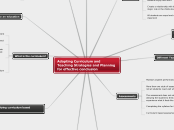Reference:
Downing, J. (2006). Students with moderate and severe disabilities: Strategies for the K-12 inclusive classroom (1st ed.). The Special Educator.
Foreman, P. (2011). Inclusion in action (1st ed.). South Melbourne, Vic.: Cengage Learning Australia Pty Limited.
Mastropieri, M., & Scruggs, T. (2004). The inclusive classroom: Strategies for effective instruction (2nd ed.). New Jersey: Pearson.
Wolfe, P., & Hall, T. (2003). Making inclusion a reality for students with severe disabilities. Teaching Exceptional Children, 35(4), 56--60.
Adapting Curriculum and Teaching Strategies and Planning for effective conclusion
Students
Be in a classroom which is welcoming
Peer assistant- allow students to help one another; this will increase their communication skills
Be treated equally
Students should feel confident and comfortable in the classroom
Steps for applying curriculum based assessments
5. Actively monitoring student progress and adjust program features in the light of progress information
4. Introducing effective instruction
3. Establishing short-term instructional objectives for the students
2. Assessing the current performance levels of the students incorporation to the curriculum
1. Identifying and analyzing the curriculum and sequencing the information
Reference: Foreman, P. 2011
What is the curriculum?
Issues with the curriculum
Target-directed learning
Prior knowledge and new knowledge links
Adapting the curriclum
There is an alternative model of the curriculum which exists for students with disabilities. They have the same KLA's but vary in the learning outcomes and the activities used for their assessment
Government standards for students and the Society's impact on what students should know
Parent Involvement
Every child has the right to an education
Regardless of what ability/disability the child has the have a right to an education
Subtopic
World wide right
Disability Standards
Extra curricula activities
For students whom finish early/ or are finding difficulty in the curriculum activity
Educational Assistants
Sometimes some classrooms may need extra assistance depending on the students and their ability. Allow the students with a disability to be focused on more
Suitable classroom setting
Every child should be able to have easy access to any classroom
Flexibility in methods of participation
Some students may not be able to do some activities, so have the same activity set out in different styles
Eliminate, as far as possible, discrimination against perons on the grounds of disability in the area of education and trainning (Commonwealth of Australia, 2005)
Students should participate in the classroom
The development of the curriculum, accreditation and delivery
Instructional Cycle
Evaluating
Implementing
Planning
Assessing
What to teach and how to teach?
Assessments
Curriculum based assessment
Completing the syllabus for the year
The assessment does not always need to be formal, but allowing the student to think it is a test etc. will allow them to experience what it feels like to be under pressure
More than one style of assessing a students knowledge as not all students react well when under pressure.
Monitors student performance and understanding
Different Teaching Strategies
After many years of research the most used version of co-teaching is 'one teach, one assist', according to Scruggs, Mastropiere, and McDuffie (2007).
Using technology in the classroom has had many benefits for the students and teachers
Students with high additional educational support require a greater commitment to innovation and effort (Downing, 2006)
Include the student in collaborative learning (Wolfe & Hall, 2003)
What is the students strengths and weaknesses
Identifying long-term goals and curriculum priorities
Helps both the students and teacher layout what they want to achieve
Teachers
All students are equal and must be treated equally in the classroom
Create a relationship with the parents as they also play a major role in the childs development and classroom actions
Be creative and effective in the tecahing styles so all students enjoy and learn.
The need to be understanding of different situations that the children may experience
It is very important for teachers to create a link with their students. This will allow the students to develop confidence with the teacher.
Inclusion Education
The concept of inclusion is based on the notion that schools should, without questions provide for the needs of all children in their communities, whatever the level of their ability of disability may be (Foreman, P. 2011).

